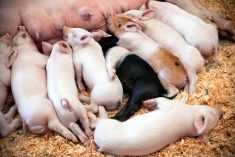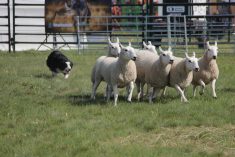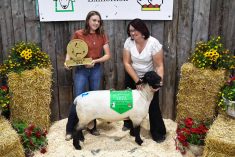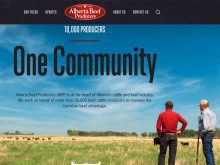A 10-day-old calf peering curiously through the rails at Bill Busslinger’s farm draws more than its share of smiles.
Cute as a teddy bear, this little black calf is a Lowline and stands less than two feet tall.
Owned by the Canadian Lowline Cattle Co., he is one of 25 on the ground in this country. Another 100 or so have been born in the United States since a group of Canadian cattle producers imported seven Lowline heifers from Australia two years ago.
They imported Lowlines because they were novel and found tremendous interest in the small black cattle that stand less than four feet tall.
Read Also

Dennis Laycraft to be inducted into the Canadian Agricultural Hall of Fame
Dennis Laycraft, a champion for the beef industry, will be inducted into the Canadian Agricultural Hall of Fame this fall.
“These are a true miniature. There is no dwarfism in them,” said Ted Jansen, the interim president of the new association and a member of the cattle company.
“We’re just in the process of deciding whether we should import some more females,” said Jansen.
The Canadian Lowline Cattle Association was set up last September with Shirley Begrand of Saskatchewan as secretary treasurer and Sid Wilkinson of Manitoba as vice-president.
Smaller meat
While acreage owners and those who breed miniature horses and donkeys have been interested in Lowlines, commercial producers are curious about the meat quality. Since they are miniature, the meat comes in smaller packages, which attracts restaurant owners.
They have been told that many Australian restaurants feature the smaller cuts of meat when they are available.
“One restaurant owner in the States said ‘I can sell a six ounce steak for 25 bucks and a 12 ounce steak, I can’t even get 10 bucks for it,’ ” said Jansen.
Those kind of anecdotes encourage Jansen and his partners to continue building their herd.
Four cows remain at Alta Genetics where they are being flushed for embryos. Each flush retrieved seven or eight embryos at a time and about half of them are viable, which is considered average.
Most of the embryos went to Black Baldie heifers because they’re good mothers and they won’t produce too much milk as young cows.
Larger calves
Lowlines are supposed to produce a 40 pound calf but Jansen said the transplanted embryos are slightly larger. Larger calves is an anomaly that often occurs with embryo transplants.
Females are more valuable now than bulls. Most of the bulls may be sold to feedlots because they are related to all the current animals on the ground. By placing them in a feedlot, the owners can see how they finish and test them to see if the meat is as good as the Australians claim, said Jansen.
The group is importing semen and embryos from New Zealand. Certain areas of Australia have a tick that causes disease so they opted to bring animals from New Zealand where that health problem does not exist.
The semen will be priced at $35 a vial, more affordable than the earlier price of $100 per vial.
The Lowline was developed at the Triange Research Centre in Australia over 20 years. Angus cattle were sorted into small, medium and large sizes. Breeding small cattle to each other resulted in the Lowline.
A mature bull weighs about 1,000 pounds and reaches a maximum of 42 inches at the shoulder. A cow is about 850 lb. and calves weigh about 40 lb.















